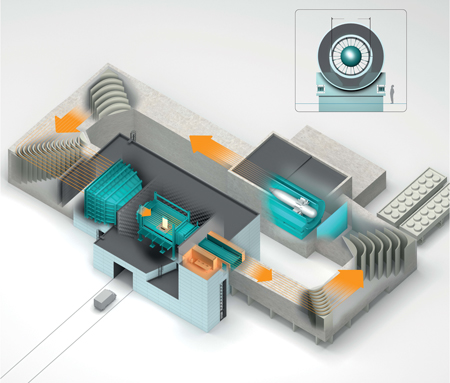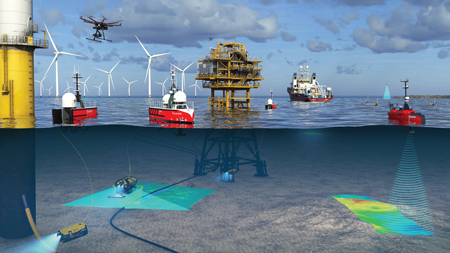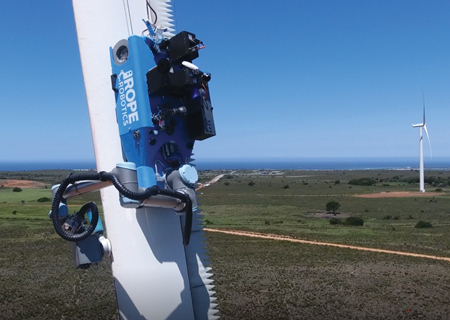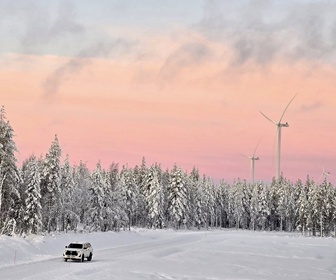- Category: Articles
 Assessing the Impact on Wind Turbine Energy Production
Assessing the Impact on Wind Turbine Energy ProductionWind turbine upgrades can potentially yield performance enhancements and an increase in annual energy production (AEP). However, the precise influence of such upgrades can be difficult to quantify, mainly due to uncertainty in the wind speed measurement and complex operational conditions. This article explores an innovative approach to the use of 10-minute SCADA data for quickly and cost-effectively evaluating the effectiveness of upgrades and the impact on wind turbine performance. Operational data is used selectively in order to match conditions before and after the upgrade, and remaining uncertainties are quantified in order to deliver results with a defined level of precision.
By Julien Tissot and Christopher Gray, i4See Tech, Austria
- Category: Articles
 Combining Infrared Thermography and AI
Combining Infrared Thermography and AIRain erosion can significantly impact wind turbine performance and maintenance costs, particularly affecting the leading edge of turbine blades. This erosion can cause pitting, surface roughness and even cracks, which compromise blade integrity while reducing aerodynamic efficiency and energy output. Energy output loss due to rain erosion is known to be approximately 0.5 to 2% and in some severe cases even more. The consequences of this damage could increase maintenance and operation costs. Traditional inspection and maintenance methods cause turbine downtime, leading to lost revenue. Modern non-destructive testing technologies such as infrared thermography combined with artificial intelligence for data analysis can provide an efficient solution to detect rain erosion on operational wind turbine blades, minimising the impact on maintenance and operation costs.
By Michael Stamm, Somsubhro Chaudhuri and Daniel Hein, BAM, Germany
- Category: Articles
 Investigating the Performance of Wind Turbine Rotors with Damaged Surfaces
Investigating the Performance of Wind Turbine Rotors with Damaged SurfacesWind turbines are designed to operate for at least 20 years and to always operate efficiently. For this reason, aerodynamic wind turbine rotor designers have ensured for many decades that the rotors can operate in a reliable way, even if the leading edges of blades are contaminated with, for example, bugs, dust or pollen. It has, therefore, been important to investigate the performance of each blade section – the aerofoils – with and without leading-edge roughness. From around 2010 there has been an increasing focus on the performance of wind turbine blades with eroded leading edges. Such erosion can appear simply by rain hitting the blade leading edge. The exact performance loss from wind turbines with eroded leading edges is neither easily predicted nor easily measured. This article describes how DTU Wind and Energy Systems in Denmark in collaboration with many companies and researchers tries to handle this issue.
By Christian Bak, DTU Wind and Energy Systems, Denmark
- Category: Articles
Technology’s Role in Making Floating Wind a Sustainable Energy Source
 Floating wind is an exciting prospect, but more work is needed to bring down costs and the levelised cost of energy to compete with traditional offshore wind and fossil fuels. This article explains how remote monitoring could make sure floating wind is financially viable.
Floating wind is an exciting prospect, but more work is needed to bring down costs and the levelised cost of energy to compete with traditional offshore wind and fossil fuels. This article explains how remote monitoring could make sure floating wind is financially viable.By Wouter Maas, Strategy Director Offshore Wind O&M, Fugro, the Netherlands
- Category: Articles
 The Open Group Extending Open-Source Data Platform to New Energy
The Open Group Extending Open-Source Data Platform to New EnergyIn 2018, a group of oil and gas companies began exploring how they could share their non-competitive assets, resources and competencies to collaboratively build a common data platform to help them utilise new technologies, such as cloud services, and operate more efficiently. They enlisted the help of The Open Group®, known for its successful stewardship of multiple forums (e.g. Architecture, Security, Process Automation, Open Footprint), to manage the new OSDU™ Forum. In 2021, this group announced the Mercury Release of an open-source data platform with capabilities supporting the subsurface realm of oil and gas. Today and going forward, work continues on expanding the capabilities to oil production, carbon capture, utilisation and storage, and new energy, including wind power. This article gives an overview of the OSDU Forum and an update on the status of its wind project.
By David W. Smith, Solutions Architect, Baker Hughes, USA
- Category: Articles
Harnessing Energy from the Wind at High Altitudes
 |
 |
By Kristian Petrick, Secretary General, Airborne Wind Europe, Belgium
- Category: Articles
Climbing Robot Performs Leading-Edge Blade Repair in the Field
 Leading-edge blade damage can compromise the aerodynamic performance of a wind turbine by up to 3%. A significant problem today, blade damage caused by rain erosion, occurring when the blade hits rain droplets at tip speeds reaching 380km/h, will only become more problematic with the ever-increasing blade lengths of modern turbines. Repairs are complex to perform, requiring not only skilled manual work hundreds of metres above the ground but also specialist tools, polymer coatings, substrate materials and application skills. Blade failure, with the consequence of long turbine downtime, can be the result if the blade is not maintained.
Leading-edge blade damage can compromise the aerodynamic performance of a wind turbine by up to 3%. A significant problem today, blade damage caused by rain erosion, occurring when the blade hits rain droplets at tip speeds reaching 380km/h, will only become more problematic with the ever-increasing blade lengths of modern turbines. Repairs are complex to perform, requiring not only skilled manual work hundreds of metres above the ground but also specialist tools, polymer coatings, substrate materials and application skills. Blade failure, with the consequence of long turbine downtime, can be the result if the blade is not maintained.By Martin Huus Bjerge, CEO, Rope Robotics, Denmark
Use of cookies
Windtech International wants to make your visit to our website as pleasant as possible. That is why we place cookies on your computer that remember your preferences. With anonymous information about your site use you also help us to improve the website. Of course we will ask for your permission first. Click Accept to use all functions of the Windtech International website.










